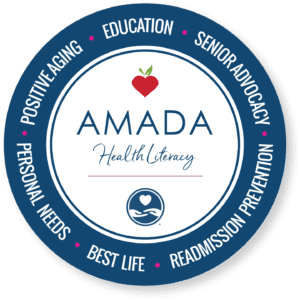The importance of Health Literacy cannot be underestimated, but the subject doesn’t have to be as daunting as it may sound. So what exactly is Health Literacy and what are the advantages of being an informed health consumer, especially as an older adult?
Promoting Health Literacy in Older Adults
Simply put, Health Literacy is defined as the degree to which individuals have the ability to find, understand, and use information and services to inform health-related decisions and actions for themselves and others. Improving our own level of Health Literacy protects us and our senior loved ones from confusion and misinformation about medication, screenings, tests, procedures, insurance options, warnings, and more.
A high level of Health Literacy allows us to ask the right questions and make informed health-related decisions. Most people do not buy a car without a thorough understanding of what they are getting into; making decisions about the best course of action to address a health issue or to achieve optimum health should be no different.
The Challenges in Understanding Medical Jargon
In seniors, disease and chronic illness become more common resulting in a general decline in overall health. This results in an increasing, often complex need for medical attention. Because there is so much information out there, whether obtained from healthcare providers, the internet, media (no one would argue that drug-related TV ads are exploding), or other sources, how do consumers — especially seniors — know for sure what they are reading or hearing, what to believe, and what to do?
The Centers for Disease Control (CDC) has long grappled with how best to process, present, and disseminate information, in short to cut through medical jargon. These tools and resources must skew a wide demographic, including the largest aging demographic – adults ages 65 and over – that may be facing diminishing vision, hearing, and cognitive ability. By 2030, estimates say there will be 71.5 million adults ages 65 and older living in the U.S., so the need for clear and precise information in user-friendly form is key. A National Assessment of Adult Literacy (NAAL) study indicates the following about older adults’ health literacy skills:
- 71% of adults older than age 60 had difficulty in using print materials
- 80% had difficulty using documents such as forms or charts
- 68% had difficulty with interpreting numbers and doing calculations
Given these findings, it’s more important than ever for families to seek assistance from professionals like geriatric care managers and senior care advisors to be able to assist those in their care to comprehend information. This includes information provided in print literature, by oral communication, and/or numeracy: the ability to understand and work with numbers. In this way, disease can be prevented or managed, with the added safeguard of being able to heed recommendations and warnings.
As an example, an Amada Senior Care advisor can assist seniors and families in creating an in-home care plan for seniors managing the symptoms of a chronic health condition. Amada is here for seniors and their families as a Health Literacy resource, so feel free to call us toll-free at 866-752-1961 or CLICK HERE to find an Amada franchise location near you.
Low Health Literacy Tied to More ER Visits and Hospital Readmissions
The Agency for Healthcare Research and Quality (AHRQ) says low health literacy is associated with increased emergency room visits, hospital readmissions, less preventive care, and poor medication administration skills. In other words, the fallout from these poor patient outcomes results in an additional financial burden to our already-overburdened healthcare system. While harnessing and distilling the challenging world of healthcare information is an ongoing pursuit for government organizations and other entities dedicated to the task, there are steps family members and caregivers can take to make the process easier for seniors.
Ways to Support a Senior’s Understanding of Health Literacy
- Experts suggest when presenting health-related information, approaching the senior in a way that communicates respect, acceptance, and support should be paramount. Creating a safe learning environment in which the senior can feel comfortable expressing what is and is not understood is the key to keeping the door to communication open.
- Be patient. Provide enough time for the senior to process new information and encourage questions.
- Link new knowledge to past experiences. Reminiscing helps the older adult reconnect with lived experiences.
- Keep the content practical and relevant to the senior’s daily activities, social structure, and physical function. Older adults tend to be more motivated when the information is perceived as a way to address a current problem.
- Speak slowly, but not so slowly that the senior becomes bored or distracted.
- Use terminology that is familiar, but do not patronize or underestimate. Age and waning comprehension don’t imply ignorance.
- Give older adults written material that reinforces the major points of the conversation. Use a larger font if possible.
- Encourage seniors, who may be grieving the loss of independence and control, to be proactive in their questions and in choosing their options, if possible.
“What Seniors Need to Know About Health Literacy,” written by Beth Herman, Amada blog contributor.



